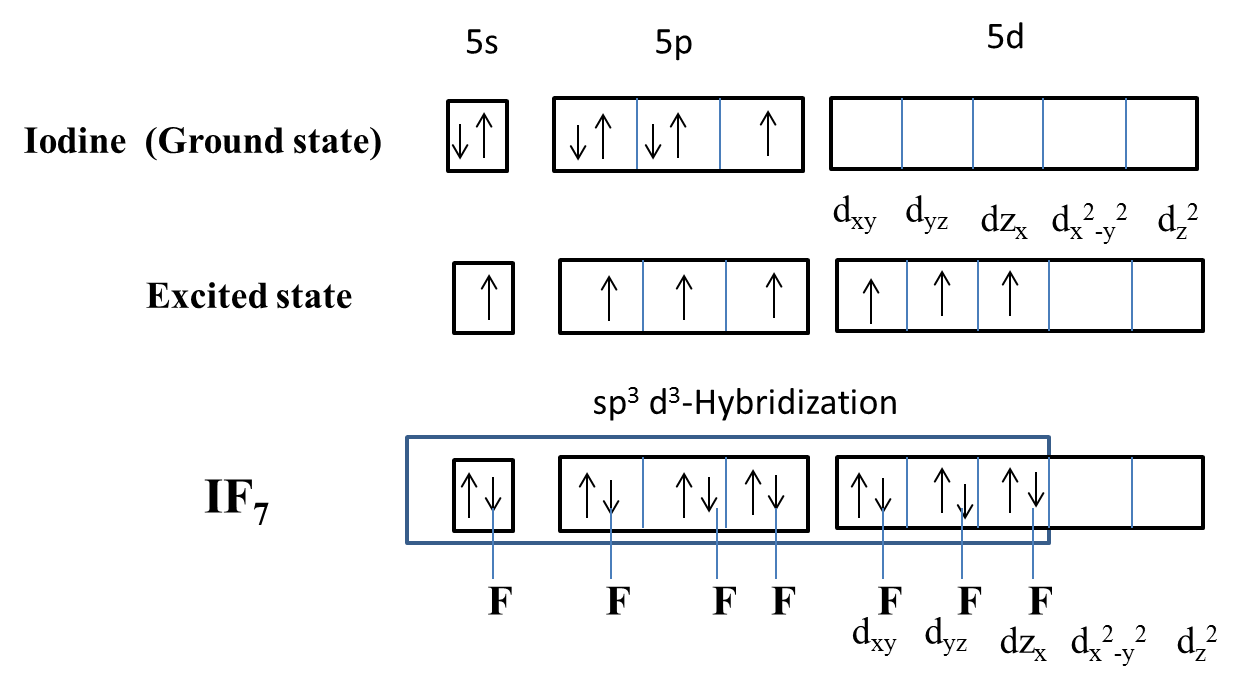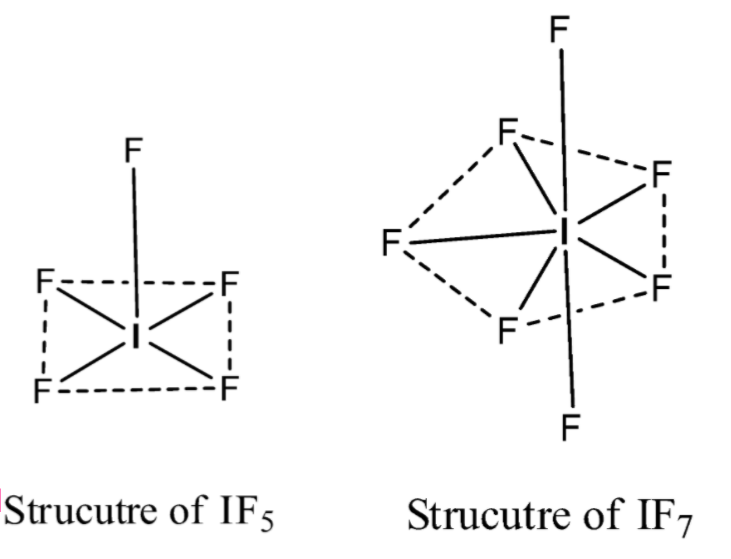
In the structure of \[I{{F}_{7}}\] (Iodine heptafluoride) ----------.
(A) \[{{d}_{xy}},{{d}_{x}},{{d}_{z}}\] orbitals are involved in hybridization
(B) Axial bonds are longer than equatorial bonds
(C) There are 10 different orthogonal angels
(D)The resultant geometry is a decahedral
Answer
573k+ views
Hint: Iodine heptafluoride, also called iodine (VII) fluoride. It is an interhalogen compound having a chemical formula of\[I{{F}_{7}}\]. As per VSEPR theory the structure of \[I{{F}_{7}}\] is pentagonal bipyramidal with a hybridization of \[s{{p}^{3}}{{d}^{3}}\].
Complete step by step solution:
The structure of \[I{{F}_{7}}\]is as follows.

The hybridization of Iodine in \[I{{F}_{7}}\] is \[s{{p}^{3}}{{d}^{3}}\] and the overlapping of fluorine with iodine orbitals we can see as follows.

Now coming to the given options, option A, \[{{d}_{xy}},{{d}_{x}},{{d}_{z}}\] orbitals are involved in hybridization, it is wrong because in the hybridization the orbitals involved are \[{{d}_{xy}},{{d}_{yz}},{{d}_{zx}}\] not \[{{d}_{xy}},{{d}_{x}},{{d}_{z}}\]. So, option A is wrong.
Coming to option B, Axial bonds are longer than equatorial bonds, yes it is true. Because from the structure we can say that the length of the axial bonds are 186pm, and length of the equatorial bonds are 179pm. So, axial bonds are longer than equatorial bonds. So, option B is correct.
Coming to option C, There are 10 different orthogonal angels. No there are only two types of orthogonal angles, there are 90 and 72. So, option C is wrong.
Coming to option D, The resultant geometry is decahedral, it is wrong. Because the resultant geometry is pentagonal bipyramidal. So, option D is wrong.
So, the correct option is B.
Note: The structure of the\[I{{F}_{5}}\]is a square pyramid or distorted octahedral and the structure of the\[I{{F}_{7}}\] is pentagonal bipyramidal. Both structures are different.

The hybridization of Iodine in \[I{{F}_{5}}\]is\[s{{p}^{3}}{{d}^{2}}\]
The hybridization of Iodine in \[I{{F}_{7}}\]is\[s{{p}^{3}}{{d}^{3}}\]
Complete step by step solution:
The structure of \[I{{F}_{7}}\]is as follows.

The hybridization of Iodine in \[I{{F}_{7}}\] is \[s{{p}^{3}}{{d}^{3}}\] and the overlapping of fluorine with iodine orbitals we can see as follows.

Now coming to the given options, option A, \[{{d}_{xy}},{{d}_{x}},{{d}_{z}}\] orbitals are involved in hybridization, it is wrong because in the hybridization the orbitals involved are \[{{d}_{xy}},{{d}_{yz}},{{d}_{zx}}\] not \[{{d}_{xy}},{{d}_{x}},{{d}_{z}}\]. So, option A is wrong.
Coming to option B, Axial bonds are longer than equatorial bonds, yes it is true. Because from the structure we can say that the length of the axial bonds are 186pm, and length of the equatorial bonds are 179pm. So, axial bonds are longer than equatorial bonds. So, option B is correct.
Coming to option C, There are 10 different orthogonal angels. No there are only two types of orthogonal angles, there are 90 and 72. So, option C is wrong.
Coming to option D, The resultant geometry is decahedral, it is wrong. Because the resultant geometry is pentagonal bipyramidal. So, option D is wrong.
So, the correct option is B.
Note: The structure of the\[I{{F}_{5}}\]is a square pyramid or distorted octahedral and the structure of the\[I{{F}_{7}}\] is pentagonal bipyramidal. Both structures are different.

The hybridization of Iodine in \[I{{F}_{5}}\]is\[s{{p}^{3}}{{d}^{2}}\]
The hybridization of Iodine in \[I{{F}_{7}}\]is\[s{{p}^{3}}{{d}^{3}}\]
Recently Updated Pages
Master Class 12 Business Studies: Engaging Questions & Answers for Success

Master Class 12 Economics: Engaging Questions & Answers for Success

Master Class 12 English: Engaging Questions & Answers for Success

Master Class 12 Maths: Engaging Questions & Answers for Success

Master Class 12 Social Science: Engaging Questions & Answers for Success

Master Class 12 Chemistry: Engaging Questions & Answers for Success

Trending doubts
What is meant by exothermic and endothermic reactions class 11 chemistry CBSE

Which animal has three hearts class 11 biology CBSE

10 examples of friction in our daily life

One Metric ton is equal to kg A 10000 B 1000 C 100 class 11 physics CBSE

1 Quintal is equal to a 110 kg b 10 kg c 100kg d 1000 class 11 physics CBSE

Difference Between Prokaryotic Cells and Eukaryotic Cells




